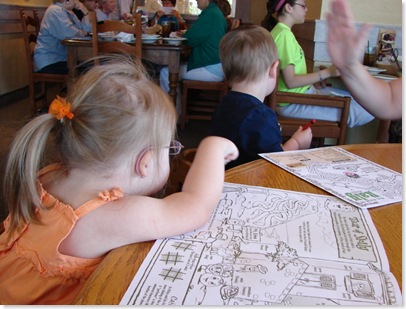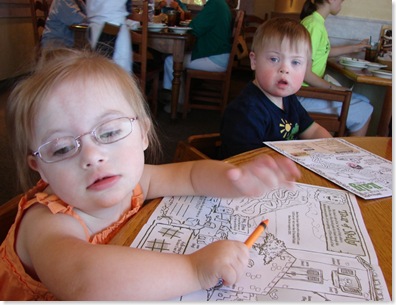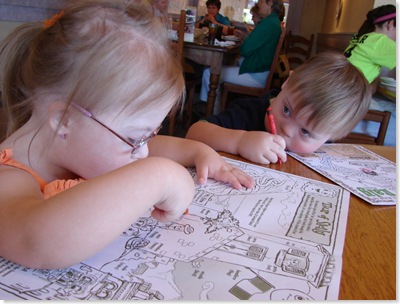Jack and his Mommy came over last week to play. I was still in my p-jammies, but he didn't even care.
First I showed him my toy shelf.
"Here, hold this."
Here's a video of us playing...make sure you watch to the end (it's short!) because we showed our mommies a new cute trick.
And this is a movie that made Mommy happy, because we're playing together. Like both of us playing with the same toy at the same time and not fighting about it or something like that.
When it was lunchtime, we went to one of our favorite places. It's called the Olive Garden, but I didn't see a garden.



(Mommy note: Don't miss Jack's face in that last pic...priceless!)
The Purpose of this Blog
My experience comes from raising my daughter, Nebraska Larae (Braska), born November 2006 with Down syndrome.
The posts on this blog are related in some way to life with DS or disability, and they are reposted here from my other family blogs. There are links to those blogs in the margin on the right side of this blog if you would like to visit them directly.
Thank you for coming by.
Wednesday, May 27, 2009
Braska: Me 'n Jack: Olive Garden
Sunday, May 17, 2009
Braska: Fun Workouts!
We went to the place they call the "motor room" to do some exercises. I loved the swing!

There was a really fun place to crawl and climb, and I just LOVE to climb, so I did this part lots of times.






Miss A and Mommy were really excited about how hard I worked and how much fun I had. I hope we get to go back alot!!!
Tuesday, May 12, 2009
Down syndrome conference, Behavior session
Feeding, Speech, and Behavior: Caring for children with Down syndrome from infancy to adolescence.
If I hear of a conference, I'm interested. If it's related to DS, I'm more interested. If it's gonna talk about feeding, speech, AND behavior, I'm there. I love to hear all the new things, tips, what's worked for others, and what the pros say. This particular conference was geared toward therapists and caregivers as well as parents. I like this type of format because the information is a bit more detailed and clinical, not just anecdotal, and I enjoy that alot.
I took alot of notes on the materials and outlines that were handed out, so I want to put together a few posts to document more clearly what was discussed and what I noted about things. It might be a bit choppy and random, but I'll try to be sure it makes some sense. As many of my posts are, this will be mostly for my own purposes but I'm sure there might be a thing or two that could be helpful to others. I'm starting with behavior because it's been a hot topic lately in a few of my circles, and I found it especially interesting.
And for the record, I have implemented a few new things that are working with Braska. She was having more "issues" with my time being occupied by Kinlee than I realized. If you want more details on that, I can address that soon.
____________________________
Understanding and Supporting Behavioral Development in Young Children
Mary Michaeleen Cradock, Ph.D.
- We all want our kids to be happy, develop to their potential, and have meaningful relationships. Behavior is a necessary element of this because it is related to happiness/satisfaction, it's critical in how children are perceived, it can support or interfere with abilities, and it can optimize experience during critical period of brain development.
- Factors that impact the behavior of young children: Age; Health: sleep/fatigue, illness, medications; Temperament (personality); Environment, including parent behavior.
- Most children, regardless of their degree of ability or disability are classified as "flexible/easy," as opposed to "feisty/difficult" or "fearful."
- The lovely stereotype that so many try to debunk whenever possible--all kids with Down syndrome are happy and amiable--is obviously not true for everyone. BUT--even though kids with DS have a range of temperaments just like other kids, it does appear that kids with DS are generally more pleasant, happier, and have a higher compliance at a younger age than kids without DS.
- Discussion/presentation focused largely on the elements of the child's environment, specifically parenting style and response to the child's behavior.
- For kids with DS: Most do NOT have significant problems in emotional, social, behavioral, or occupational realms. Many have healthy social adjustment.
- A small percentage of kids with DS have a type of behavior disorder, like ADHD, oppositional disorder, phobias, or autism.
- Kids with DS tend to have these behavioral characteristics
Increased off-task behavior, avoidance, strong-willed behavior. This is often seen when they are presented with tasks that are above their level. Most often used: avoidance.
Limited persistance. If they are unable to do something the first or second time, they will often give up and be satisfied to do something different instead of the original task. Example: If given several toys to play with and one of them has small switches or knobs that they cannot yet grasp or use, they may be just as pleased to go on to the next toy instead of trying repeatedly over a period of time to conquer the difficult toy.
Limited self-regulation. Delay of gratification or waiting may not be understood. - Avoidance often includes "charming." Though we all like the cute smiles, the sudden cuddles, the waving or blowing kisses, charming can often be used to avoid experiences or lessons that would be helpful and are necessary. Charming allows the child to focus on the social element instead of the problem solving that might be required in the situation. It can cause them to miss a learning opportunity. And it can become a habit. We must teach the appropriateness of actions like this as they grow up so that it does not become a crutch for them that costs them important learning experiences. Example: When a child is working with a therapist who is requiring them to do things that are difficult or uncomfortable, they may (Braska does) begin to smile or attempt to hug or distract with another cute trick like saying silly things, dancing, giggling, etc. The therapy is important and needs to be continued, so the charming must be handled appropriately so that the learning is still primary and the child is not allowed to succeed in changing the direction of the situation.
- It is a myth that children with DS cannot change their behavioral style. Evidence suggests behaviors CAN be changed, and, often, modifying the environment makes a difference.
- Remember that kids with DS are visual learners. Their verbal working memory is less well-developed than typical kids their age. Example: When telling a child to go to their room and get their shoes, they may go to their room, see a book, sit down and read, while completely forgetting that there was a second task in the instruction. This skill takes longer to develop, so expecting one without the skill to do this can cause what is perceived as behavioral issues, but it is simply that the child is not yet able to complete this task in that way. Give one-step instructions, and when transitioning to two-step, go with the child to assist them in remembering at first, so that the distraction is caught at onset instead of after they've been sitting there reading for 10 minutes when you go to find them.
- Social attention is a powerful force. Especially parental attention. Removing it can be a very effective method of discouraging unwanted behavior.
- Inconsistent behavior is expected. Kids with DS tend to show more instances of doing something several times and then not doing the same skill, for no apparent reason. This is why consistency is necessary when teaching a new skill.
- Behavioral challenges interfere with learning new skills, socially isolate the child, may result in self-injury or injury of others, and can cause damage to environment.
- Solving behavioral challenges:
Define current behavior and the desired behavior
Identify the function of the behavior
Analyze environment for contributing factors
Make a plan to address
Test your theory
Modify - Define behavior.
Antecendents: setting, activity, time of day, others present, child's condition--before the behavior. What was going on before the behavior? Be specific.
Behavior: Specifically what is the child doing that is, in this case, unwanted.
Consequences: Actions and others' behavior that follow the behavior. - Most parents or caregivers tend to focus on the B(behavior) and C(consequences) but the biggest difference is made in A(antecedents).
- Scenario: Jacob's doctor visit. Antecedent: Going to the doctor's office. Behavior: Protesting, Kicking, Pulling away. Would run away if not being held. Consequences: Taken out of the office by mom, remained out for 15 minutes til calm. Returned to the office with mom and nurse.
- Name desired behavior: Go to the doctor's office without protest.
- Questions to ask: Is this in the child's skill set? Is additional skill development needed to meet the requirements of the desired behavior?
- It's helpful to think in non-negative terms for desired behavior, eg. "Enter doctor's office calmly and politely", instead of "Don't kick, scream, and protest when going to the doctor." Another example, related to potty training, eg. "Let's keep pants dry today," instead of "Don't wet your pants."
- Identify the function of the behavior. What is the payoff? Possibilities: Gain attention, gain tangible consequences, sensory experience, escape or avoidance, communication, emotional regulation, release tenion, fill a need.
- The most common functions of unwanted behavior in kids with DS: Gain attention, through charming behavior, social gaze, crying, hitting. Escape or avoidance, through tantrums, charm, focus on other activities/distract.
- Function of Jacob's behavior in scenario. Possibilities: Avoid new situation or old traumatic situation, gain attention of nurse/mom.
- Analyze environment for contributing factors. Setting, time of day (very important!), others' behavior/reinforcement. Ask who, when, and where.
- Behaviors are maintained by reinforcement, either positive or negative. Positive reinforcement: Behavior results in the desired activity or item. Negative reinforcement: Behavior results in removal of preferred activitiy or object.
- Consider when the unwanted behavior does NOT occur. What is the setting then? Eg. Braska's behavior of refusal to eat. When does it not occur? Braska eats much better in a restaurant or public setting usually.
- Adjust desired behavior according to information about skill set and when the avoidance does NOT occur. Example: If the desired behavior is that I want Braska to mind when I give her an instruction, it might be too vague at her current level. If she seems to always avoid if I am not right there next to her to enforce the instruction, I might want to scale down the expectation to begin by requiring her to mind if I am sitting next to her (Give me the book.) Then expand as that skill becomes more consistent to where she can mind if I am across the room. (Put your toys in the drawer.)
- Make a plan to address the behavior. Address the antecedents: Modify the environment if it seems to contribute to the unacceptable behavior. Modify the demand by offering choices or offer collaboration/assistance to help them accomplish the task so they are not instantly overwhelmed with the request. Address the consequences: Pay attention to the positive things and remove attention from the negative (when no harm is done). If the desired behavior is to sit calmly in the doctor's office, praise the child for sitting quietly even if it has only been a short while. Praise for calmness can even be given when the child is being held or read to. The key is to associate positive attention to the positive behavior so that the child is not only getting attention, though negative, through unacceptable behavior.
- Extinction burst: Try to extinguish the behavior, they ramp up the defiance, parent escalates the extinction attempt, child ramps up again. Example given: When a person puts money in a soda machine and no soda comes out, they push the button a second and third time, pressing it repeatedly. If no soda comes out, they may bang on the front of the machine. If there is still no soda, they may shake the machine or rock it back and forth. If this does not work, they throw up their hands, yell an expletive, kick a wall, and walk away. Extinction burst. Like a child who almost seems to have to work himself to a frenzy and then they seem to find a release finally and become instantly much calmer. If the soda came out after the shaking of the machine, that would cause that person to go directly to that level each time he wanted a soda. The same is true of a child. If they receive their desired reaction, be it attention, candy, a toy, or an activity, when they scream and writhe on the floor, they will then use that over and over to get what they want. If they are given what they want ONLY when they are exhibiting acceptable behavior, they will learn that is the best option. (Unexpected factors of hunger, fatigue, and outside changes can alter this, of course.)
- To solve behavior challenges, the hypothesis must be tested more than once. If a behavior has been around for months, it will take at least a few weeks of consistency to re-teach the desired behavior. Trying something a couple times and counting it a failure is giving up to soon.
- Never forget to involve all the "key players" in working on new behaviors. Extended family, friends who are around often, daycare providers, teachers, etc. If a behavior is allowed by grandparents it will be almost impossible to avoid at home. Consistency is ultimately important. Again, this seems to be even more important in kids with DS than typical-developing kids.
- Sometimes it is helpful to get input from others who know the child well to determine the antecedents of the unacceptable behavior. They may notice things a parent doesn't. A common pitfall in solving behavioral challenges is setting the bar too high. Make sure the child is able to comply with request. Expecting actions that are out of the child's skill set will only encourage frustration and thereby avoidance.
- Always choose ONE behavior issue to work on at a time. Choose battles carefully and focus attention on one thing instead of solving all the issues at once.
- Parents must make sure to maintain their own health, mental and physical, in order to be able to have the energy, positivity, and stamina to deal with these challenges. Take care of YOU.
- Example given by audience of issues they are dealing with: Child with glasses, removes them immediately when grandma turns attention away from reading or playing to answer a phone or tend to cooking. Suggested actions: Praise the child for keeping the glasses on even for one or two seconds during a quick look-away. Start by turning face away but leaving hand on her shoulder or arm to show attention but not visual. Praise when she leaves them on during that turning away. Build up time turned away, then begin to step away, sometimes for only a second or two, and return to praise her for keeping them on. Return to read or play again before attempting again. Increase slowly of several days or weeks depending on the child's response. If the child removes the glasses, replace them without speech, no lecture, no scolding, just replace them and continue on. This is taking away the "drama" that can often be the desired response. If grandma must step away for a moment, remove the glasses and take them with her (like to check on dinner) and then return to replace the glasses and continue the one-on-one time. This will help remove the possibility for negatve reinforcement and the chance to defy.
- Example of issue given by audience: Running away when outside playing or in parking lot. Suggested actions: Praise child for walking next to parent, even when parent is holding onto child. "I love when you walk next to me. It's very nice to have you hold my hand!" Spend more time praising the child for remaining close in the yard than time spent chasing or yelling at the child as the parent chases the child. If the child runs, when she is caught, do not lecture or scold again, this is once again attention/drama. Remove the child from danger without excessive talking. Practice can be very successful. Take the child to the car or to the store solely to reinforce proper behavior, so that there is not the stress of actually needing to accomplish shopping or being in a hurry to get somewhere.
- Book suggestion: Achieving Best Behavior for Children with Developmental Disabilities by Pamela Lewis.
Session notes on Feeding and Speech to come soon.
Monday, May 11, 2009
Braska: Daddy is a big boy now
Today is Daddy's birthday. He's 35. Mommy said maybe he'll grow up now. But I'm not supposed to tell that to anyone. Shhhhhhhhhhh...
After he came home from work, I showed him one of my new favorite games to play... It's fun. You should try it too!
Happy Birthday, Daddy!! You're a really good daddy!
Thursday, May 7, 2009
Rock On!! You know you want to!
Check this out... like actually check it out, not skim right by. Just peek in there and see how cool a guy can be!
Andrew, an 18-year-old drummer with Down syndrome, sells t-shirts with his Rock On! logo on them to make money to go to college. Here's the link to his site. It's still new and in progress, but I just love the logo, and there will be one of these in our home in some form very soon. Andrew's mom posted on the iVillage DS board, and I linked over and checked him out.
I just love stories like this... and I hope that we can all Rock On!
Sunday, May 3, 2009
Hey DS Parents, Dental question
When did you take your kiddo for their first dental check?
If you haven't yet, were you given any info from anyone about when you should take him/her?
What was the reasoning for that timing?
How does tooth-brushing go at your house? Easy? A fight? Every day?
Anyone need to do sedation for dentistry?
I'm pondering how this is going to work for Braska, as she is so NOT into people messing with her mouth or putting anything in it.
To see comments to this original post, click here.
Friday, May 1, 2009
Braska: Tea Party
A couple weeks ago Mommy took me to a tea party with a bunch of other friends who are "extra" cute like me. It was a day just for girls at a pretty place to eat. Mommy told more about it here and here if you want to see what she said.
I got to wear a new outfit that had pretty yellow in it. I like yellow, and Daddy does too.
We sat at little tables that were all made pretty with teacups and flowers.
This is one of my new friends, Rylie.
And this is my new friend Reagan who sat by me. She had a really pretty hat.
Since Daddy had to work extra that day, Kinlee got to come, too.
It was a nice day, even though I got a little upset a couple times when it got really loud and busy in there. It was a really little room, but I think it was a nice time out for us girls.







